Table of Contents
ToggleIntroduction
The A7M266 is one of these boards that newer really grew on me. There are several great AMD760 based motherboards out there, which either look exciting, have great features or even both of these aspects. The A7M266 falls in neither of these categories. It just hasn't got that little “something” like let's say the Epox 8K7A or Abit KG7.
Even Asus themselves dropped this model pretty early in favour of their VIA and ALi based offerings (A7V266 and A7A266), so there are also no different variants of this model available.
When the A7M266 was first announced, it featured 4 memory slots, a different set of capacitors around CPU socket and ATX Connector and had another DIP switch in the top right corner. I found a tiny picture of it in this announcement from October 2000: https://tweakers.net/nieuws/14028/asus-a7m266-press-release.html
The first models, that can be found in reviews in early 2001, already lack half of the memory slots and the DIP switch, just as my Rev. 1.04 board. So it seems like a lot of features of this first concept got dropped early, presumeably to get the product ready as soon as possible.
But enough of the history lesson, let's see if the A7M266 is able surprise or even inspire during this review.
Gallery
Specifications and Features
Chipset:
- AMD 761 Northbridge
- VIA 686B Southbridge
CPU Support (with latest BIOS):
- Athlon Thunderbird (ALL)
- Athlon XP Palomino (ALL)
- Duron Spitfire (ALL)
- Duron Morgan (ALL)
Memory Support:
- 2 DDR DIMM slots, up to 2 GB total
Expansion Slots:
- 1x AGP Pro slot (1,5V) up to 4x
- 5x PCI slots
- 1x AMR slot
Connectors (internal):
- 2x IDE (UDMA100)
- 1x Floppy
- 2x USB 1.1
- Asus iPanel connector
- 3x 3-pin fan connectors total (1x CPU, 2x chassis)
Connectors (external):
- 2x PS/2
- 2x COM/RS-232
- 1x Parallel Port
- 2x USB 1.1
- 3x 3,5" Audio Jacks (Line-Out, Line-In, Mic)
- Gameport
You might have noticed, that I didn't mention the audio chipset specifically, as I think far better solutions than the old onboard chipsets are readily available for little money. Very commonly recommended are the Creative Soundblaster Live! cards for example, which offer fantastic compatibility with our beloved old games and sound far better than any onboard solution of that era.
I also don't list (from a retro-gamers perspective) useless connectors and features like IR, Smartcard- or Wake-on-LAN connectors and so on.
Overclocking Features:
- Adjustable FSB (BIOS) from 100 to 180 MHz in 1 MHz steps (Jumper Free Mode) OR
- Adjustable FSB (DIP Switch): 100 / 103 / 105 / 110 / 115 / 133 MHz (Jumper Mode)
- Adjustable VCore (Jumper) from 1,100 V to 1,850 V in 0,05 V steps (Jumper Mode ONLY)
- I/O Voltage Clock Generator (Jumper): 3,30 / 3,45 / 3,56 V
- I/O Voltage RAM / Chipset (Jumper): 2,70 / 2,80 / 2,90 V
The A7M266's OC options are completely usesless in my opinion. First of all, there is no option to adjust the multiplier. The active multiplier gets displayed in the BIOS, but it is greyed out and cannot be changed, even in “Jumper Free Mode”. There are some old reviews that tell you the multiplier can be adjusted if the CPU is unlocked, but this is simply not true - I tested it myself. The manual also doesn't mention this feature.
There are also tables on the PCB that show settings for a “DSFID” DIP switch, which would allow multiplier adjustments. But this DIP switch is nowhere to be found and it also isn't mentioned in the manual, too. Seems like Asus planned to include this feature, but, for whatever reason, complete removed it in the end.
Secondly, there is no way to adjust the VCore, if you run the board in “Jumper Free Mode”. To enable this mode, the VCore jumpers have to be set to “CPU default”, but then there is no option to adjust the CPU voltage from within the BIOS!
And since there is no way to overvolt the CPU when OC'ing, you will barely get into a situation, where you have to raise the I/O voltage. So these options are also largely useless. The only thing you can do at all in “Jumper Free Mode” is adjusting the FSB. Great design.
Documentation, Downloads, Drivers
Hardware and BIOS aside (for the moment) - the first big positive aspect when you chose a mainboard of a still existing manufacturer for your retro build, is, that you'll most likely won't have too much trouble finding documentation and BIOS files.
The support site for the A7M266 can be found easily when you go to your search engine of choice and type "a7m266 support".
Asus still offers the manual, the latest BIOS versions and even (audio) drivers for download. The chipset driver however, can not be found when selecting a specific OS; you have to choose “Others”, where the “AMD miniport” driver is offered for download. The ZIP file contains the AMD AGP miniport driver for Win98, ME as well as Windows 2000. The driver versions vor 98SE and ME are the latest available, the Windows 2000 version (5.22) is outdated however. The latest version is 5.33, which also supports Windows XP.
Unfortunately Asus does not bundle a BIOS flash tool with the BIOS downloads and the utility is also not available for download on the A7M266's support page at all. As a workaround, you can enter the support section of another Asus board of that time, for example the A7V266-E, where you can find the required "Aflash" utility here:
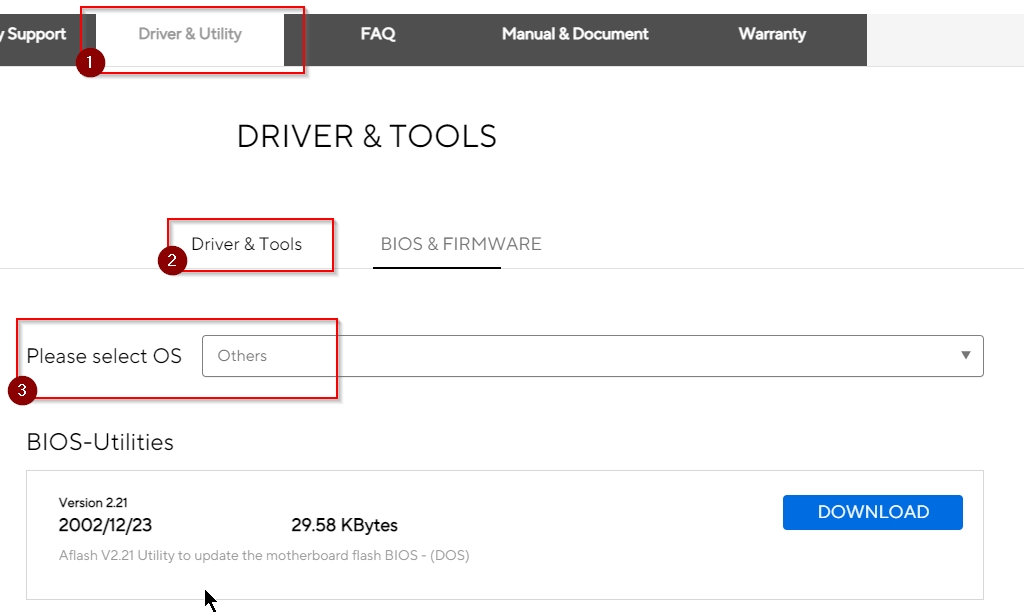
There is also a CPU support list directly on the A7M266's support page, where you can easily look up compatible CPUs.
On top of that, Asus also offers a global CPU Support search. Here you are not only able to search for a specific mainboard model but also the other way round: If you have an old CPU laying around, you can use the search form to find compatible mainboard models and maybe to get inspiration for your next retro build.
You can find it here: https://www.asus.com/support/cpu_support
Design & Layout
The overall look of the A7M266 is quite ok compared to some other entries of the “classic” Asus A7xxx Line-up, which mostly look a bit quirky to my eye.
Objectively speaking, the only major fail in terms of the layout is the position of the ATX power connector, which forces you to route the ATX power cable over the VRM area to have it somewhat out of the way. The good news is, that there is enough space above the CPU socket to have the cable going there, even with a large cooler like the Alpha PAL 8045 installed.


The area around the CPU socket is quite “roomy” in general, so large coolers should not be a problem at all. I also like the orientation of the CPU socket. With its plastic mounts facing the memory slots and VRM area, the CPU cooler can be installed or removed without the need to take the motherboard out of the system.
To see if the space around the CPU socket lives up to the expectations, I tested the following eight CPU coolers towards compatibility:
- Thermaltake Silent Boost K7
- Cooler Master HHC-001
- Swiftech MCX 370
- Alpha PAL 6035
- Alpha PAL 8045
- Smartcooler 60mm
- Arctic Cooling Copper Lite

Like expected, all of these coolers could be installed without any issues.
The IDE and floppy connectors are placed perfectly on the right edge of the PCB and there is enough space between the memory slots and the AGP port, so that the memory sticks can be installed and removed while the AGP card remains in the slot. This is of course possible, because Asus decided to only feature five PCI slots on the A7M266, instead they placed a useless AMR slot on the board.
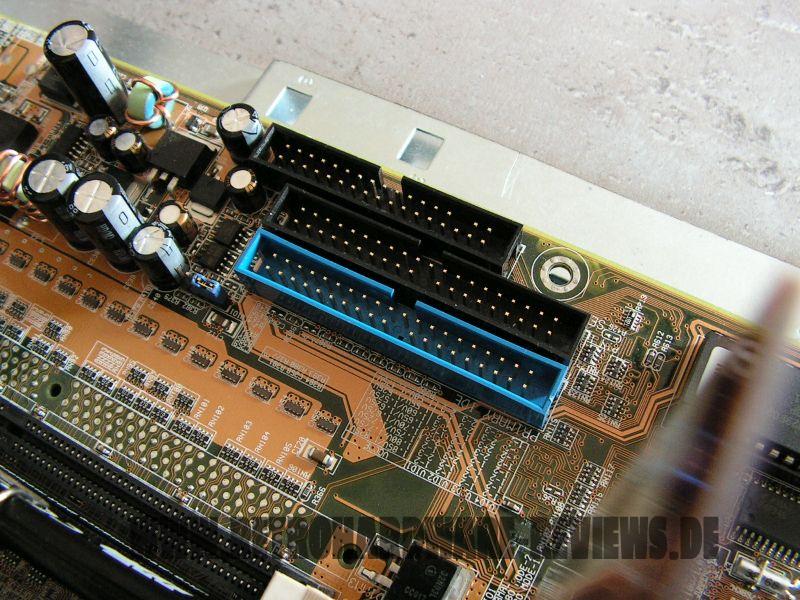
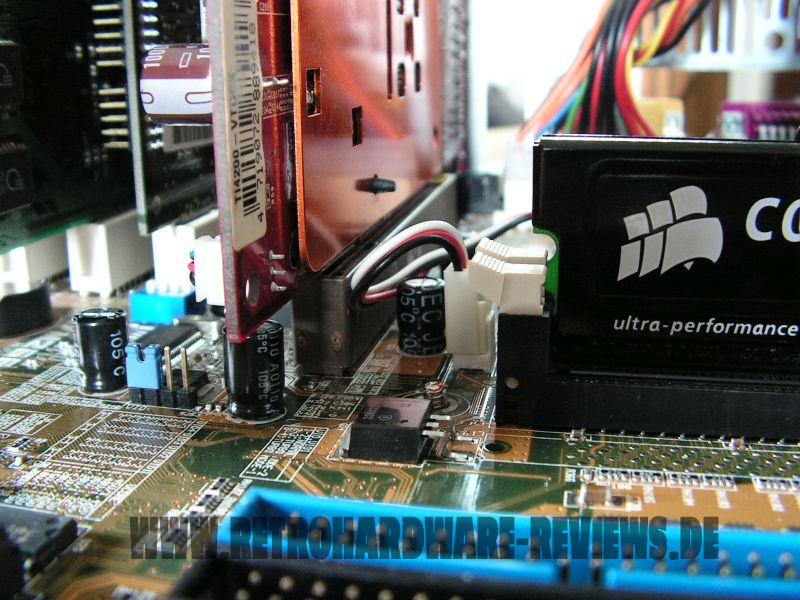
The connector for the second casefan is, for what ever reason, located in the top right corner - of course it would have been better placed on the left side of the PCB.
The CMOS battery is too close to the PCI slots, so it get's possibly covered by long PCI expansion cards. But i've seen even worse layout decisions before.
Nevertheless - the layout does not leave a too refined impression overall. For example, we have the “VIO1” for VDIMM located in proximity to the IDE ports, “VIO0” for chipset voltage can be found close to the AGP port and the jumpers for VCore are in the lower left corner. The “JEN” jumper (for jumper free mode) is located in the lower middle.
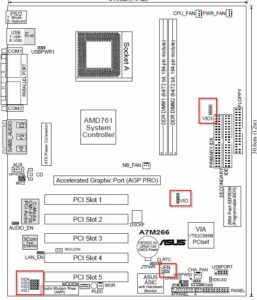
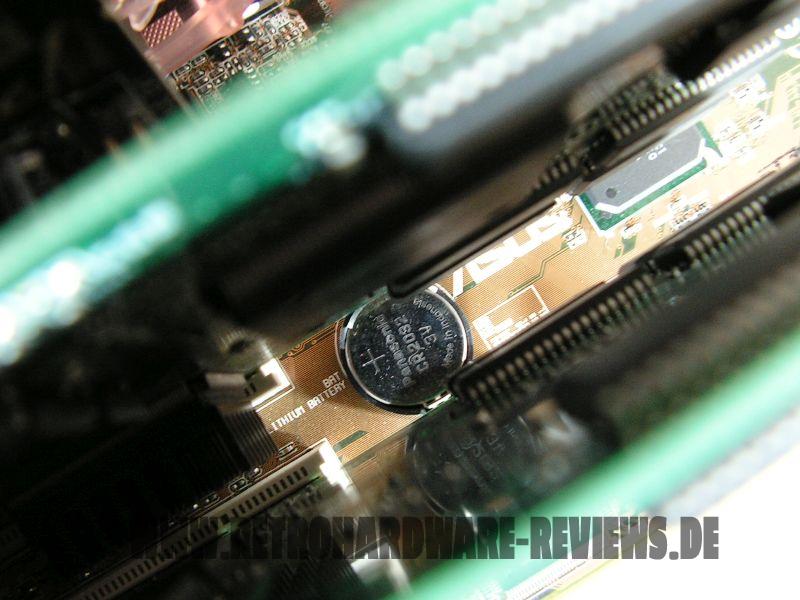
So if you plan to tweak your system, you'll have a serious workout hovering over the whole PCB to adjust all the settings, that many other manufactures at that time already integrated into the BIOS..
It fits well into the picture, that the tables for the multiplier adjustment are still printed on the PCB, but the corresponding DIP switch is not present at all. And we are talking about a Rev. 1.04 board here - the DIP switch was removed before the board was brought to market and is not even mentioned in the manual.

Test-System and Parts
Baseline Setup:
- CPU: AMD Athlon Thunderbird 1200C (FSB133)
Because I want to compare 1st Gen Socket A mainboards to their DDR follow-ups I have to use a CPU, which is available in FSB100 and FSB133 versions with the same clockspeed. Since I sadly don't have a Thunderbird 1400 B at my disposal, I will use the Thunderbird 1200 for my reviews and comparisons of these boards, which I have in the “B” (FSB100) and “C” (FSB133) version.
- RAM: 1x Corsair CMX512-3200C2 (XMS3202v4.2) = 512MB PC400 CL2
This Corsair XMS stick should allow the tightest timings at 266 MHz DDR and its size of 512MB is the perfect choice for Windows 98SE.
- VGA: MSI Geforce 4 TI4200-VTD8X
To remove any GPU bottleneck for testing, I chose a Geforce 4 Ti as the primary graphics card for my test setups. The Geforce 4 Ti series are also known to pull a lot of power from the AGP port, so that possible problems in that department can also be revealed. It is also somewhat period correct and a good match for a high performance retro-machine that should be able to run late Windows 98SE games without any issues.
- VGA2: 3dfx Voodoo 5 5500 AGP
Many people consider the Voodoo 5 5500 the perfect card for (Win9x-) retro gaming. The Voodoo 5 benefits from a beefy setup, so a powerful Athlon Thunderbird or early Athlon XP is the perfect match for this card.
- Audio: Creative Soundblaster Live! (SB0060)
Creative's Soundblaster Live! can be found in many retro-machines. It offers great sound, perfect Win98SE compatibility and is still widely available for reasonable money. It was also known to cause problems with VIA-based 686B southbridges using old BIOS revisions and VIA chipset drivers. All this should be history at this point, but double checking on pontentially affected mainboards is still not a bad thing to do.
- LAN: 3Com Etherlink XL PCI
Just a good, reliable choice for networking. All legacy Windows versions all the way up from Win95 have built-in drivers for it, which is also a huge “plus”.
- HDD: Western Digital WD200BB (20GB 7200RPM)
No special intention behind this drive, it is just “there” and still works fine.
Additional Hardware for certain Tests:
- Silicon Image Sil3512 SATA Controller & Samsung PM871 128GB SSD
These two will help me measure the PCI bandwidth.
- Hitachi Deskstar T7K500 (500GB 7200RPM)
This drive will tell us, how big we can go with the onboard IDE connectors and how the performance is like.
- 2x Voodoo 2 12MB (SLI)
A pair of Voodoo 2s is a must have for any retro-machine, that doesn't feature a 3dfx card as the primary VGA solution. They offer compatibility to older Glide games and can be used with any more powerful primary graphics card. It is an important thing to know, how well these perform and if there are differences between all the available Socket A chipsets of that era or even between boards using the same chipset.
Drivers used:
- Chipset: AMD AGP Miniport 4.80 + VIA Hyperion 4in1 4.56v (without the AGP drivers)
- Geforce 4: nVidia Forceware 43.45
- Voodoo 5: Amigamerlin 2.9
- Voodoo 2: FastVoodoo 4.6
- SB Live!: Some driver from my archive, not shure 😉
- 3Com NIC: Windows 98SE preloaded driver
- SATA Controller: Some driver from my archive, not shure 😉
System Setup and Usage
The first thing I noticed during the setup, is that my test CPU (Athlon 1200C) got reported as “Athlon 0 MHz”. This also happened with a Thunderbird 1400C I slapped in for a second test. While this seemed to be a cosmtic issue only, I downgraded the BIOS version from 1008b002b to the latest “stable" version 1007. There is no changelog for the latest beta available anyway and the final BIOS version already offers support for all Athlon XP Palomino CPUs, adds LBA 48bit support for large hard drives and also includes compatibility fixes for Geforce 4 cards.

The slowest Athlon I have ever seen 😉
So, after I had the BIOS issue sorted out and the memory configured, I had the pleasant task to find out how to distribute the expansion cards across the PCI slots. Fortunately, the A7M266's manual didn't let me down in that regard, as I found this helpful table inside:

It is a bit misleading, since it suggests, that both the videocard as well as the onboard audio chip assign IRQs on two INT lines. But this is only half of the truth. Of course every PCI slot is connected to every INT line and follows a hierarchy, based on which connected devices assign IRQs on the respective INT lines. If a device, like a graphics card for example, only needs a single interrupt, it of course does not assign it on two INT lines at the same time. If the graphics card needs another interrupt (for example for a TV tuner like the ATI All-in-Wonder cards), it will be assigned on the secondary INT line and so on.
So - long story short: based on what I found in the manual, I checked the actual assignment, which is like that:
- INT-A: AGP
- INT-B: onboard audio
- INT-C: AMR/free
- INT-D: 2x USB controller
- PCI #1: shared with AGP
- PCI #2: shared with audio
- PCI #3: no sharing
- PCI #4+5: shared with USB
After I got this information together, I disabled all unnecessary components like onboard audio, serial and LPT ports and floppy controller and installed the PCI cards as follows:
- PCI #1: free
- PCI #2: SB Live!
- PCI #3: Voodoo 2
- PCI #4: Voodoo 2
- PCI #5: NIC
To disable the onboard audio, by the way, it is not sufficent to disable it inside the BIOS, you also have to disable it by the jumper that is present on the board - otherwise it will still show up in the device manager.
After I was finished with the Voodoo 2 and Geforce 4 benchmarks, I removed them, installed the SATA card to PCI #3 and replaced the nVidia card with the Voodoo 5.
Upon next boot however, the system got stuck. So I resetted the system and could successfully boot into Windows afterwards. However, when I installed the driver, the system completely froze during the process. Because of that, I let the SB Live! and the SATA controller change places and this time all drivers installed fine and I could complete all benches without further problems.
Benchmarks
Synthetic Measurements
Before we get into the 3DMark and gaming benchmarks, let's have a look at some theoretical numbers. These synthetic tests will exhibit the differences between the several chipsets and boards better than any game benchmark and provide us with "background information" that might be of use in understanding the timedemo results later.
Memory Performance: AIDA64 Cache & Memory Benchmark
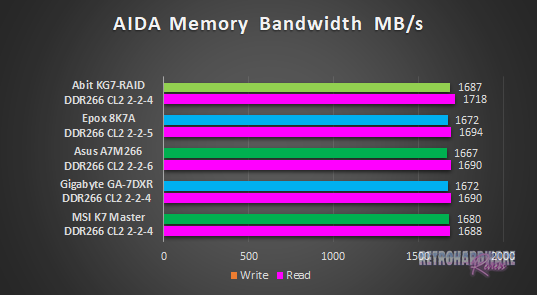
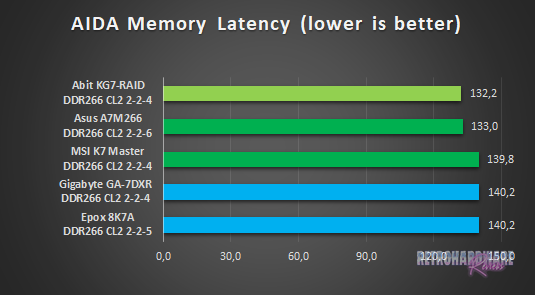
In terms of memory bandwidth, all AMD761 based boards perform very similar. The A7M266 takes third place in terms of read performance (with performance identical to the Gigabyte GA-7DXR), but shows the lowest write rates among the boards tested. This is most likely because of the fastest configurable memory timings only being CL2 2-2-6.
In the memory latency measurements, it nevertheless shows very good values, second only to the Abit KG7-RAID.
Application Performance: 7-Zip
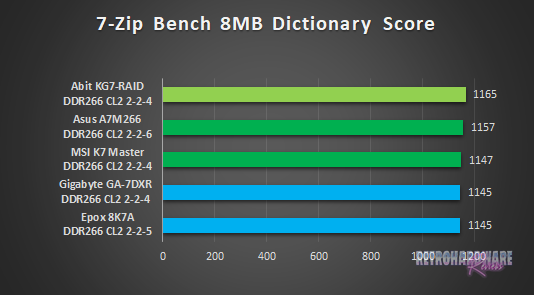
The low memory latency seems to help in the 7-Zip benchmark, as the Asus board takes second place, trailing the Abit KG7-RAID again.
AGP Performance: Final Reality Benchmark
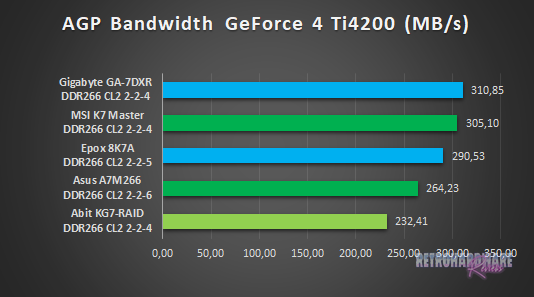

AGP bandwidth with the GeForce 4 Ti is a bit lacking, the A7M266 ranks fourth here with only around 264 MB/s. It takes first place with the Voodoo 5 installed, however, but all boards show very similar bandwith results using this card.
AGP and PCI Performance: 3DMark 2000 and ATTO
3DMark 2000 as a whole is very focused on TnL and is by far not as interesting for retro-hardware comparisons as its predecessor. Its “High Polygon Count, 1 Light” test, however, is another good way to measure the AGP performance. In opposite to the Final Reality test, the general system performance is also somewhat of importance. The benchmark was executed with the Geforce 4 Ti installed.
To measure PCI performance, I installed a Windows 98SE compatible SATA controller with a Samsung PM871 128GB SSD connected into the system. For the bench, I chose 1024 to 4096 KB block size and picked the overall best values for the read and write throughput. This test will show, which maximum performance can be expected with fast storage options like SATA or SCSI and maybe gives a hint, if the chipset might be good for Voodoo 2 cards.
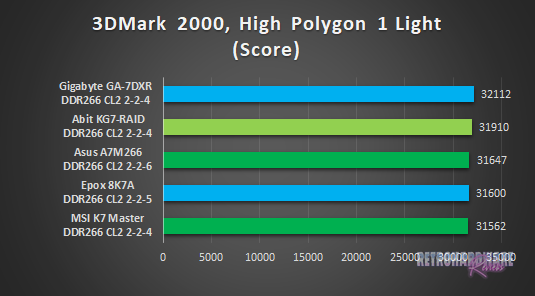
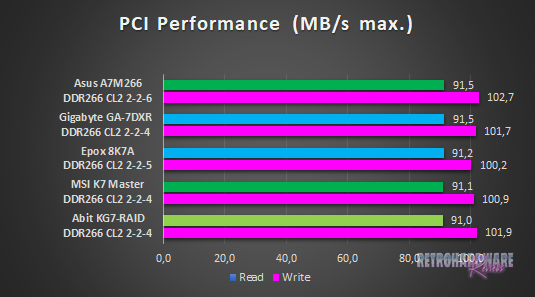
Third place in the 3DMark 2000 sub-test for the A7M266, scoring slightly better than the boards of EpoX and MSI. The overall good memory performance seems to even out the rather low AGP bandwidth a little.
The PCI bandwidth of the board is top notch however, with the best results for both read- and write throughput among the the tested boards.
Storage Performance: HDTach
To measure the performance of the board's IDE and (if available) onboard IDE RAID solutions' performance, I benched one of the latest and fastest IDE drives (the Hitachi Deskstar T7K500 500GB) with the HDTach benchmark. I also tried a much more “recent” drive (the Western Digital Blue Edition 500GB), which should be even faster in theory, but the Hitachi drive produced much better results in this test.
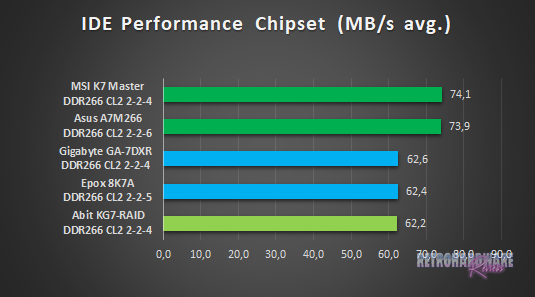
Nothing to complain in terms of IDE performance either, the A7M266 takes second place in the HDTach benchmark, closely following the MSI K7 Master.
Gaming Benchmarks
Now that we got all the theoretical performance numbers, let's see how the contenders perform in 3D gaming benchmarks.
3D Performance: 3DMark99max
3DMark99max was released in early 1999 and comes without support for Hardware TnL. The maximum supported (hardware-) DirectX level is DX6. It is a great benchmark to reveal good overall system performance, as it rewards good memory bandwidth and latency more than the slight clockspeed advantage, that some boards have because of their factory-overclocked FSBs.
- Version: "latest"
- Settings: standard
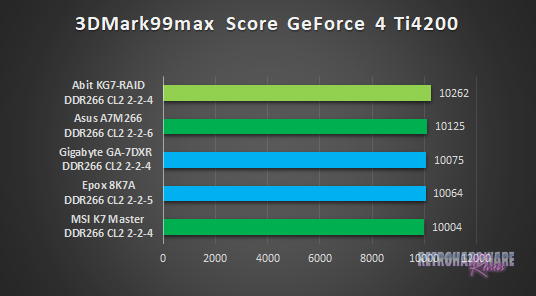
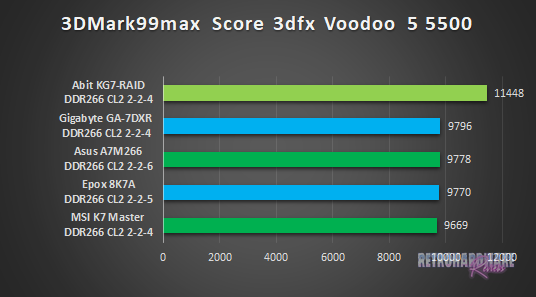
Just like seen in the 3DMark2000 test, the lacking AGP bandwidth with the GeForce 4 Ti seems not to hinder the A7M266 too much. It takes second place in 3DMark99max with this card installed.
With the Voodoo 5 installed, it gets surpassed by the Gigabyte GA-7DXR, which puts it in third place with only 8 points ahead of the 8K7A.
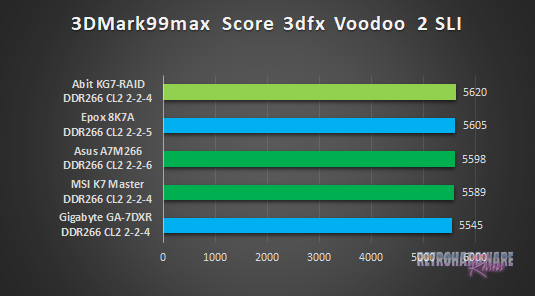
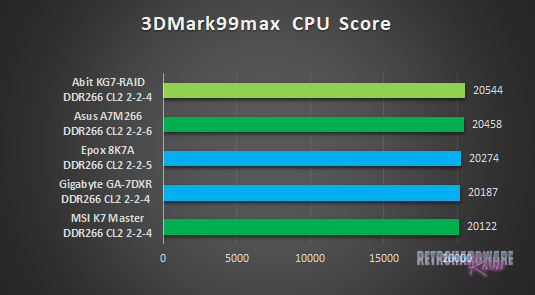
The A7M266 takes third place for the Voodoo 2 SLI run of 3DMark99max. The results are very close however, with first and fourth place only about thirty points apart. In terms of CPU performance in 3DMark99max, the Abit and Asus boards are slightly ahead of their competitors. The A7M266 ranks second here, around ninety points behind the KG7-RAID.
3D Performance: Unreal Tournament (UT99) Timedemo(s)
Unreal Tournament (UT99) was released in November 1999 and is notorious for its hunger for CPU power. I chose to use two different timedemos for comparison, of which the utbench.dem timedemo is heavily CPU bound and therefore qualifies to measure the general performance of the boards. The second timedemo benchmark.dem is as GPU limited as possible in this game. This will reveal, how much impact a faster board can still have in more GPU limited situations. This game is also perfect to show, on which chipsets and boards Voodoo 2 cards run best.
- Version: 4.36
- Settings: High, Min desired Framerate "0", Show Decals [x], Use Dynamic Lightning [x]
- Geforce: D3D
- Voodoo 2 and Voodoo 5: Glide
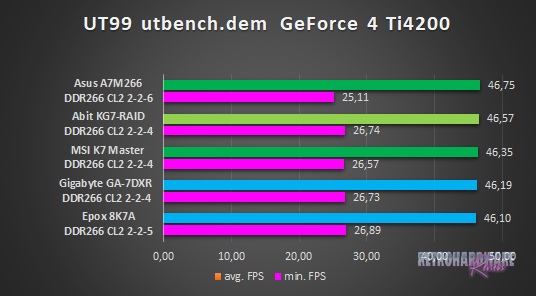
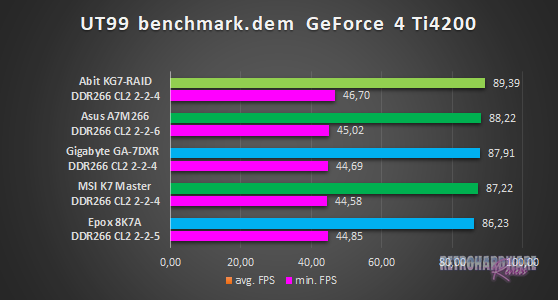
The A7M266 takes first place in the utbench timedemo in terms of average framerate, although the results are very close across the board. Its minimum achieved framerate, however, is noticeably lower than on all other boards.
In the benchmark.dem timedemo, the result looks more solid. The A7M266 achieves the second highest framerate for both average and minimum FPS here, second only to Abit's KG7-RAID.
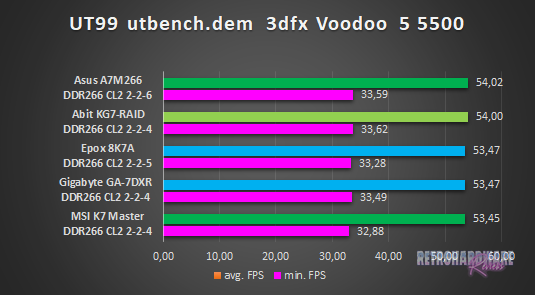
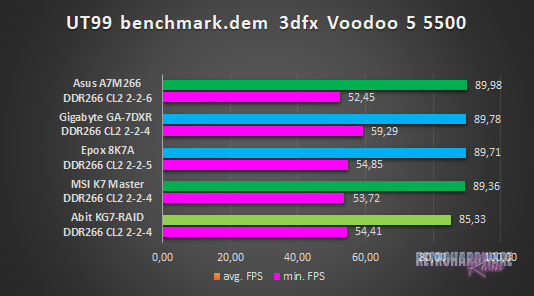
The A7M266 and the Abit KG7-RAID both are a tiny bit ahead of the competition in average and also minimum framerates in the Voodoo 5 run of the utbench timedemo. Both contestants perform basically identical with almost non-existant differences.
In the second timedemo, the Asus board takes first place, but, like in the GeForce 4 Ti run of the utbench timedemo before, its minimum framerate is the lowest of all boards tested.
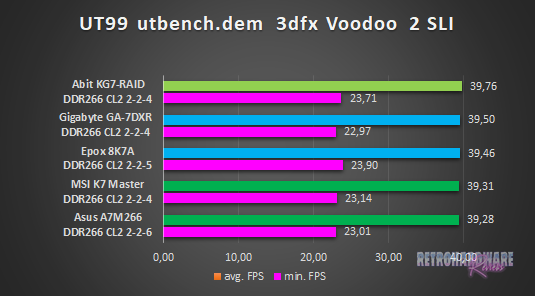
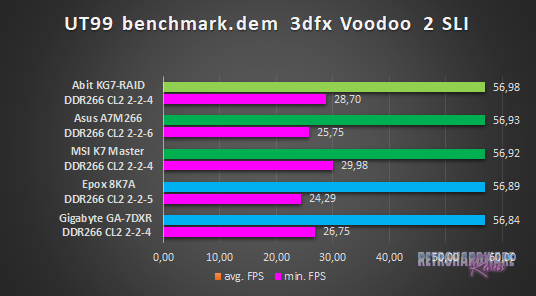
In the Voodoo 2 SLI run of the utbench timedemo, the Asus board achieves the lowest average FPS as well as the second lowest minimum FPS of all boards. Since the results for both minimum FPS are very close among all participants, this is not a huge problem.
This is to be seen somewhat differently in the second timedemo, where the average FPS for all boards are almost identical, but the minimum achieved framerates show noticeable differences. The A7M266 doesn't look to good in this respect, showing the second lowest framerate.
3D Performance: Quake III Arena Timedemo
Quake 3 Arena was released shortly after Unreal Tournament, in December of 1999. It is known to reward fast memory latency and with its normal preset, it is completely CPU limited; at least for the GeForce 4 and the Voodoo 5. The Voodoo 2 SLI cards clearly limit the Athlon 1200 here, as the timedemo will show.
- Version: 1.32
- Settings: “Normal” Preset, only resolution changed to 1024x768x16
- Geforce 5 and Voodoo5: OpenGL
- Voodoo 2: “Voodoo” Renderer (miniGL)
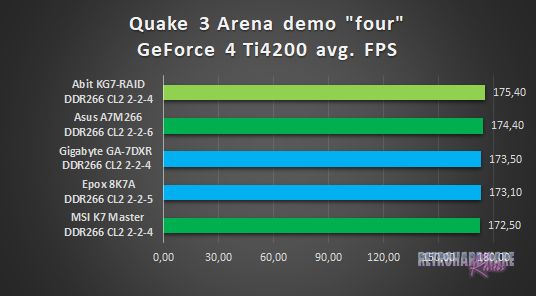
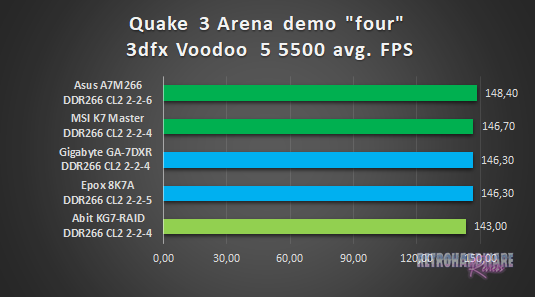
The Asus board shows a strong performance in Quake III Arena. It achieves second place in combination with the Geforce 4 Ti and takes first place with the Voodoo 5 installed, keeping the rest of the boards at a noticeable distance.
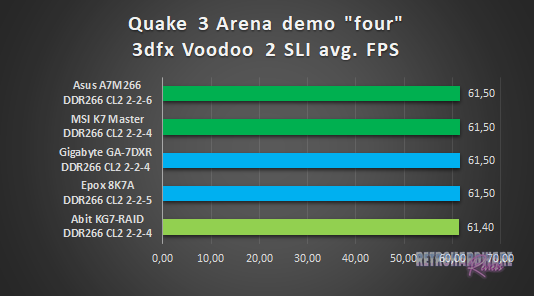
The Voodoo 2 SLI setup clearly limits here. All boards score the same FPS, with only the Abit KG7-RAID a close 0,1 FPS behind.
Summary & Rating
Asus A7M266 (AMD760)
-
Layout
-
Features
-
Overclocking Options
-
Compatibility
-
Documentation & Support
-
Performance: GeForce 4 Ti 4200
-
Performance: Voodoo 5 5500
-
Performance: Voodoo 2 SLI
OVERALL
| Pros | Cons |
| + Fantastic PCI performance | – OC options mostly useless |
| + Lots of space around CPU socket | – Only two memory slots |





